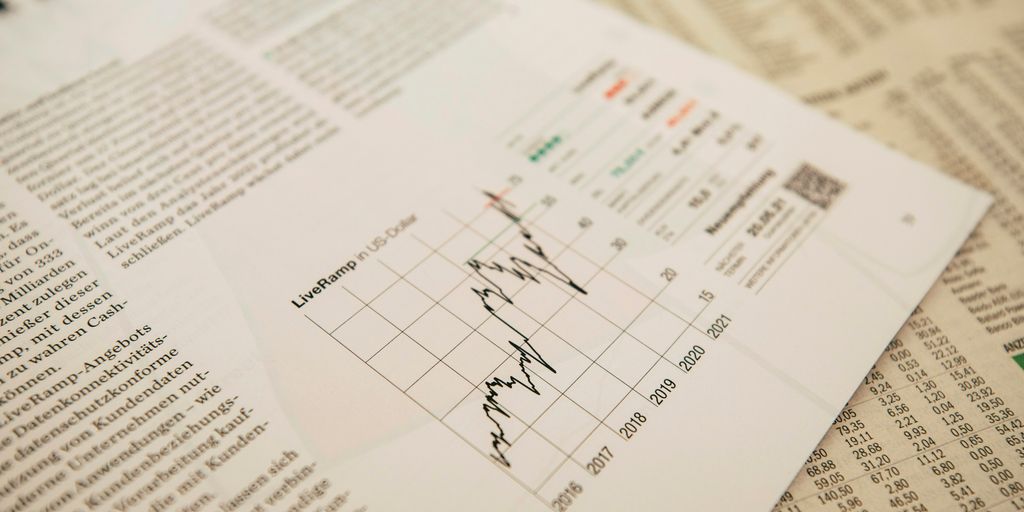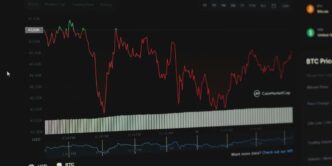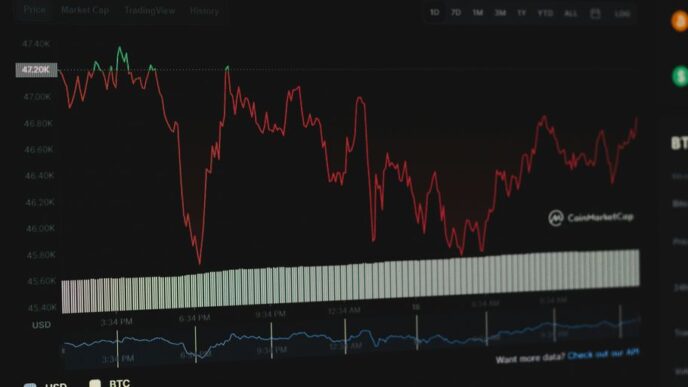Thinking about the 30 year UST, often called a Treasury bond, can feel a bit complex if you’re not in the finance world every day. These are basically long-term loans you make to the U.S. government. They pay interest twice a year and then give you your original money back when the bond matures, usually after 30 years. People often look at them because they’re seen as pretty safe, especially compared to stocks. But like anything, their value can change based on a bunch of things happening in the economy and with government policy. Let’s break down what makes these 30 year USTs tick.
Key Takeaways
- The 30 year UST, or Treasury bond, is a long-term debt security issued by the U.S. government, typically maturing in 30 years. It pays interest twice a year.
- Demand for 30 year USTs can be influenced by factors like the Federal Funds Rate, the U.S. trade deficit, and regulatory policies affecting financial institutions.
- Inflation expectations play a big role; if people expect prices to rise, they’ll demand higher yields on bonds to keep their purchasing power.
- Market sentiment, including expectations about future Federal Reserve actions and economic growth, can cause the yields on 30 year USTs to move.
- While generally considered safer than stocks, 30 year USTs still carry risks, including interest rate risk, where rising rates can cause bond prices to fall.
1. Understanding Treasury Bonds
Treasury bonds, often called T-bonds, are a big part of the U.S. government’s debt picture. They’re basically IOUs from Uncle Sam with a longer fuse, typically maturing in 20 or 30 years. When you buy a T-bond, you’re lending money to the government, and in return, they promise to pay you interest every six months until the bond matures. At the end of that term, they give you back your original investment, the face value of the bond. It’s a pretty straightforward deal.
How They Work
Think of T-bonds as a way for the government to fund its operations. They sell these bonds to investors, and that money helps pay for everything from infrastructure projects to national defense. The interest rate, or coupon rate, is fixed when the bond is issued. This means you know exactly how much interest you’ll receive throughout the life of the bond. This predictability is a major draw for many investors.
Key Features
- Maturity: As mentioned, these are long-term. The most common are the 30-year bonds, but 20-year ones exist too.
- Interest Payments: You get paid interest twice a year. This regular income stream can be quite appealing.
- Safety: Because they’re backed by the full faith and credit of the U.S. government, T-bonds are considered one of the safest investments out there. The risk of the government defaulting is extremely low.
- Taxation: Interest earned from T-bonds is taxable at the federal level, but it’s exempt from state and local income taxes. This can be a nice perk depending on where you live.
Buying T-Bonds
You can buy T-bonds directly from the government through TreasuryDirect.gov, or you can purchase them through a brokerage account. Many people also buy them indirectly through mutual funds or exchange-traded funds (ETFs) that focus on bonds. The government sells new bonds through auctions, and you can participate in these if you want to buy them right when they’re issued. If you miss the auction, you can always buy them on the secondary market from other investors. Understanding how these Treasury bonds fit into your portfolio is key for long-term investing.
2. Treasury Bills (T-Bills)
Short-Term Stability: Understanding Treasury Bills (T-Bills)
When we talk about short-term government debt, Treasury Bills, or T-Bills, are usually the first thing that comes up. These are basically short-term IOUs from the U.S. government, with maturities that don’t go beyond 52 weeks. Think of them as a really safe place to park your cash for a short period. They’re sold at a discount to their face value, and when they mature, you get the full face value back. That difference? That’s your taxable interest income. It’s a pretty straightforward way to earn a little something without taking on much risk.
Key Features of T-Bills
- Maturities: You can find T-Bills with terms of 4, 8, 13, 17, 26, or 52 weeks. This variety means you can match them up with your short-term cash needs.
- Discount Basis: They’re issued below face value, which is how the interest is generated.
- Low Risk: Because they’re backed by the U.S. government, they’re considered one of the safest investments out there. Default risk is practically non-existent.
- Liquidity: Their short-term nature makes them quite liquid. If you need your money back sooner, it’s generally easy to sell them on the secondary market.
How T-Bills Work in Practice
The U.S. Treasury sells these bills through regular auctions. They announce how much they plan to sell and when, and then investors bid. You can put in a bid yourself, or if you’re a smaller investor, you can often submit a non-competitive bid, which means you agree to accept the average yield determined by the auction. This makes it pretty accessible for most people to participate. T-Bills are often used by investors to add stability to their portfolios, acting as a counterbalance to more unpredictable assets.
3. Treasury Notes (T-Notes)
Treasury Notes, or T-Notes as they’re often called, are a pretty common type of U.S. government debt. They fall in the middle ground when it comes to how long you’re locking up your money, with maturities typically ranging from two to ten years. Unlike Treasury Bills, which are sold at a discount, T-Notes pay out interest twice a year, every six months, until they mature. This makes them a good option if you’re looking for a more predictable income stream from your investments.
The interest payments from T-Notes are exempt from state and local taxes, which can be a nice perk depending on where you live. When you buy a T-Note, you’re essentially lending money to the U.S. government for a set period, and they promise to pay you back the face value at the end, plus those regular interest payments along the way. You can buy these directly from the government or through a broker. If you need to sell before maturity, you can do so on the secondary market, but the price you get will depend on current interest rates and demand.
Here’s a quick look at how T-Notes stack up:
- Maturity: 2 to 10 years.
- Interest Payments: Paid every six months.
- Taxation: Interest is exempt from state and local taxes.
- Risk: Considered very low risk, backed by the U.S. government.
These notes are a popular choice for investors who want something safer than stocks but with a bit more yield than short-term bills. They offer a balance between income generation and a relatively short commitment period compared to longer-term Treasury bonds. You can find more information on how these compare to other short-term debt like Treasury Bills (T-Bills) on the TreasuryDirect website.
4. Treasury Inflation-Protected Securities (TIPS)
What are TIPS?
Treasury Inflation-Protected Securities, or TIPS, are a bit different from your standard Treasury bonds. Their main job is to protect your investment’s buying power from inflation. They do this by adjusting the principal amount based on changes in the Consumer Price Index (CPI). So, if inflation goes up, your principal goes up too, and vice versa. This means the interest payments, which are a fixed percentage of the principal, also adjust. It’s a way to keep your investment’s real value steady over time.
How TIPS Work
When you buy a TIPS, you’re essentially buying a bond whose value is tied to inflation. Here’s a quick rundown:
- Principal Adjustment: The principal amount of the TIPS is adjusted every six months based on the CPI. If the CPI rises, your principal increases. If it falls (deflation), your principal decreases.
- Interest Payments: TIPS pay interest twice a year. The interest rate is fixed, but it’s applied to the adjusted principal. So, as the principal changes with inflation, so do your interest payments.
- Maturity Payout: When the TIPS matures, you get back the adjusted principal or the original principal, whichever is greater. This protects you from losing money if there’s deflation over the life of the bond.
Why Consider TIPS?
For investors worried about inflation eroding their savings, TIPS can be a solid choice. They offer a way to maintain purchasing power, which is especially appealing in uncertain economic times. You can find TIPS with different maturities, typically 5, 10, and 30 years, allowing you to match them with your investment timeline. It’s a good idea to look into how Treasury Inflation-Protected Securities can fit into your portfolio if you’re concerned about the rising cost of goods and services.
5. Treasury STRIPS
What are Treasury STRIPS?
Treasury STRIPS, which stands for Separate Trading of Registered Interest and Principal of Securities, are a bit different from your typical Treasury bond. Think of it like this: a regular Treasury note or bond has two main parts – the regular interest payments (coupons) and the final principal payment at the end. STRIPS essentially take those parts and chop them up, selling them as individual, zero-coupon securities. So, you can buy just the principal payment, or you can buy a specific interest payment. It’s a way to customize your cash flow from government debt.
How STRIPS Work
When you buy a STRIP, you’re buying it at a discount to its face value. Then, when the security matures, you get the full face value back. There’s no interest paid along the way, hence the "zero-coupon" label. This structure is pretty appealing for investors who want a predictable lump sum at a specific future date. For example, a pension fund might buy STRIPS that mature exactly when they need to make a large payout years down the line. It helps them match their assets with their future liabilities. You can find these securities created from Treasury notes and bonds, and they are traded on the secondary market. It’s important to know that the interest earned on STRIPS is taxed annually, even though you don’t receive the cash until maturity. This is sometimes called "phantom income," and it’s something to keep in mind for your tax planning. You can find more information on how these securities are structured on the Treasury website.
Why Investors Choose STRIPS
So, why would someone go for STRIPS instead of a regular Treasury? Well, it really comes down to planning. If you know you need a specific amount of money on a specific date in the future, STRIPS can be a really clean way to achieve that. They offer a guaranteed payout at maturity, which is pretty attractive in uncertain economic times. Plus, like other Treasuries, the interest is taxed at the federal level but not by states or cities, which can be a nice perk. It’s a way to get a fixed return without the reinvestment risk that comes with coupon payments. You’re essentially locking in a yield for a specific maturity date.
6. Yield Curve Dynamics
The Treasury yield curve, often called the term structure of interest rates, is basically a snapshot of what the market thinks about interest rates at different points in the future. It plots the yields of U.S. Treasury securities against their maturities, from short-term bills to long-term bonds. Think of it as a report card on the economy’s expected health and inflation.
What Makes the Curve Move?
It’s not just one thing, but a mix of factors. The government issuing more debt, for instance, can push yields up. If the economy looks like it’s really taking off, investors might expect higher inflation and demand higher yields on longer-term bonds. Conversely, if things look shaky, people tend to flock to the safety of Treasuries, which can push yields down.
Shapes of the Curve
We usually talk about a few common shapes:
- Normal Yield Curve: This is the most typical one, where longer-term bonds have higher yields than shorter-term ones. It slopes upward, suggesting investors expect growth and maybe a bit of inflation down the road.
- Inverted Yield Curve: This is when short-term yields are higher than long-term yields. It’s often seen as a warning sign for a potential economic slowdown or recession.
- Flat Yield Curve: Here, short-term and long-term yields are pretty much the same. It can signal uncertainty about the future economic direction.
How Short-Term Rates Affect Long-Term Rates
Generally, long-term yields tend to follow short-term rates, which the Federal Reserve directly influences. When the Fed hikes short-term rates, longer-term yields usually follow, but they might not move as much or as quickly. This can cause the gap between short and long-term yields to narrow, making the curve flatter. When the Fed cuts rates, the opposite can happen, potentially steepening the curve.
7. Federal Funds Rate Impact
The Federal Funds Rate, set by the Federal Reserve, acts like a benchmark for interest rates across the entire economy. When the Fed decides to adjust this rate, it sends ripples through the financial markets, influencing everything from short-term borrowing costs to the yields on longer-term investments like our 30-year UST. It’s a pretty big deal, honestly.
How Rate Changes Affect Yields
When the Fed hikes the federal funds rate, it generally pushes other interest rates higher. This means that newly issued Treasury bonds, including those with longer maturities, will likely offer higher yields to attract investors. Conversely, if the Fed lowers rates, we typically see yields on Treasuries move lower. It’s a direct connection, though not always perfectly in sync. For instance, if the Fed raises short-term rates, longer-term yields might not jump up as much if investors believe those higher rates will eventually slow down the economy and curb inflation. This can lead to a flattening of the yield curve, where the difference between short-term and long-term yields narrows.
Key Takeaways:
- Direct Influence: Changes in the federal funds rate directly impact borrowing costs across the financial system.
- Yield Curve Dynamics: Fed rate adjustments often lead to shifts in the yield curve, influencing the spread between short-term and long-term Treasury yields.
- Investor Expectations: Market participants constantly adjust their expectations for future Fed policy, which in turn affects current Treasury yields. For example, if investors anticipate more rate cuts than previously thought, it can push yields lower.
It’s worth noting that while the federal funds rate is a powerful driver, other factors also play a role in shaping Treasury yields. Things like inflation expectations, government borrowing needs, and global capital flows all contribute to the complex picture. Understanding these interconnected elements is key for any investor looking at the US Treasury yields market.
8. U.S. Trade Deficit Influence
Foreign Investment Flows
When the U.S. runs a trade deficit, it means more money is flowing out of the country to pay for imports than is coming in from exports. This excess money often finds its way back into U.S. markets, and a big chunk of it lands in U.S. Treasury securities. Think of it like this: foreign companies and governments that sell a lot to the U.S. end up with a lot of U.S. dollars. They need a safe place to put that money, and U.S. Treasuries, especially the long-term 30-year bonds, are a top choice because they’re seen as very secure and liquid. This steady demand from overseas can help keep yields on these bonds lower than they might otherwise be. It’s a bit of a balancing act; a large deficit can mean more dollars abroad looking for a home, which can support Treasury prices and thus depress yields. However, if foreign investors start to worry about the U.S. economy or the value of the dollar, this demand could dry up, potentially pushing yields higher. It’s a dynamic that investors definitely keep an eye on, especially when considering the long-term Treasury yields.
Impact on Treasury Demand
So, how does this trade deficit actually affect the demand for, say, that 30-year Treasury bond? Well, a persistent trade deficit means a continuous inflow of foreign capital. This capital needs to be invested. U.S. Treasury bonds, particularly the longer-dated ones, are attractive because they offer a relatively safe haven for these funds. This increased demand from foreign buyers can absorb a significant portion of the new debt the U.S. government issues to finance its operations and deficits. When demand is high, bond prices tend to go up, and when bond prices go up, their yields go down. It’s a bit counterintuitive, but more demand can mean lower returns for investors in the short term. This is a key reason why understanding international capital flows is important for anyone looking at the bond market.
Economic Implications
From a broader economic perspective, a large and growing trade deficit can signal underlying issues. It might suggest that the U.S. is consuming more than it produces, or that its currency is too strong, making imports cheaper and exports more expensive. While the influx of foreign capital can temporarily keep interest rates down, a sustained deficit can also lead to concerns about the nation’s long-term economic health and its ability to service its debt. This is where things get complicated for investors. They have to weigh the immediate effect of foreign demand on yields against the potential long-term risks associated with a large trade imbalance. It’s a complex interplay of global finance and national economic policy that directly influences the cost of borrowing for the U.S. government.
9. Regulatory Policies and Demand
Regulatory policies can really shake up demand for Treasury securities. Think about banks, for instance. When regulators tell them they need to hold more of what they call ‘high-quality liquid assets,’ that often means more demand for Treasury notes. It’s like a rule that pushes them to buy safer stuff. Pension plans and insurance companies are in a similar boat; they have to play by the rules too, balancing making money with keeping things steady. This regulatory environment creates a consistent, underlying demand for Treasuries.
It’s not just about rules, though. The government’s own actions, like increasing the issuance of Treasury bills to finance spending, also play a big part. More supply means they might have to offer slightly higher rates to attract buyers.
Here’s a quick look at how some factors influence demand:
- Bank Capital Requirements: Higher ratios mean banks need more safe assets, often Treasuries.
- Pension Fund Obligations: Meeting return targets while managing risk drives demand for stable investments like Treasuries.
- Insurance Company Reserves: Similar to pensions, regulatory requirements for reserves influence their Treasury holdings.
- Government Spending: Increased spending can lead to more Treasury issuance, impacting supply and potentially yields.
10. Inflation Expectations and Yields
When people talk about what makes Treasury yields move, inflation expectations are a big piece of the puzzle. Think about it: if you’re lending money, you want to get paid back enough to cover the fact that prices might go up while you’re waiting. So, if everyone starts expecting prices to rise faster, they’ll demand a higher interest rate on their bonds to make it worth their while. It’s like a built-in adjustment.
The Treasury yield curve itself actually gives us a pretty good snapshot of what the market thinks inflation will do over different timeframes. If longer-term yields are higher than shorter-term ones, it often suggests people expect inflation to be higher down the road. It’s not a perfect crystal ball, of course, but it’s a strong indicator.
We saw this play out recently. For instance, investors are keeping an eye on upcoming inflation data, like the July CPI report, which is expected to show a modest monthly increase. This kind of data directly influences how traders price in future inflation, and consequently, how they view yields. If inflation numbers come in hotter than expected, you’ll often see yields tick up as investors adjust their expectations. It’s a constant back-and-forth.
Here’s a quick look at how inflation expectations can shift yields:
- Higher Inflation Expectations: If the market anticipates rising prices, investors will demand higher yields on new bonds to compensate for the expected loss of purchasing power. This pushes existing bond prices down.
- Lower Inflation Expectations: Conversely, if inflation is expected to cool, investors may accept lower yields, leading to higher prices for existing bonds.
- Uncertainty: When there’s a lot of uncertainty about future inflation, perhaps due to policy changes or unexpected economic events, yields can become more volatile as investors try to price in a wider range of possibilities. This uncertainty can make it tough to get a clear read on where things are headed, and it’s something many are watching closely as key inflation data is released.
So, when you’re looking at Treasury yields, always remember to consider what the market is thinking about inflation. It’s a pretty direct relationship, and understanding it helps make sense of a lot of the market’s movements.
11. Tariff Policies and Inflation
Tariff policies can really shake things up for inflation, and by extension, Treasury yields. If the government decides to slap on bigger tariffs, it can make imported goods more expensive. This often leads people to expect prices to keep going up, which is basically inflation expectations rising. When that happens, investors usually want a higher return to make up for the fact that their money will be worth less in the future. So, you see yields on things like 10-year Treasury bonds start to climb.
It’s a bit of a domino effect. Higher tariffs can mean higher inflation, and higher inflation expectations usually mean higher Treasury yields. It’s not always a direct one-to-one relationship, of course. The market is always trying to figure out what’s going to happen next, and there’s a lot of uncertainty, especially with new policy announcements on the horizon. For instance, the market is watching closely to see how these policies might affect the overall economy and what the Federal Reserve might do in response. This uncertainty can keep Treasury yields pretty jumpy.
Here’s a quick look at how tariffs might play out:
- Increased Import Costs: Tariffs make foreign goods pricier for consumers and businesses.
- Higher Inflation Expectations: When people expect prices to rise, they often demand higher wages and returns on investments.
- Yield Adjustments: To compensate for expected inflation, Treasury yields typically move higher.
It’s worth noting that the actual impact can depend on many factors, including how widespread the tariffs are and how businesses and consumers react. Some analysts at J.P. Morgan Global Research are keeping a close eye on the economic effects of these tariffs, given how dynamic the situation is. Understanding these potential shifts is key for investors trying to make sense of the bond market. economic effects of U.S. tariffs
12. Fed Rate Cut Expectations
Market Expectations Shift
The market’s view on when the Federal Reserve might start cutting interest rates has really changed lately. Back in September 2024, people were expecting quite a few cuts, but now, the general feeling is that rates will stay put for longer. We’re talking about the market pricing in only about 31 basis points of cuts for 2025, and the expected top rate, or terminal rate, is just a bit over 4%. This is a big jump from just a few months ago when the market was pricing in around 120 basis points more cuts. Basically, investors are now thinking "higher for longer" when it comes to interest rates.
Factors Influencing Rate Cut Outlook
So, what’s causing this shift? A few things seem to be at play. For starters, economic growth projections have been bumped up. President Trump’s re-election and the economy showing more resilience than expected are big reasons for this. When the economy looks stronger, the Fed usually feels less pressure to cut rates to stimulate it. Also, there’s a lot of talk about new tariffs and how they might affect inflation. While the exact impact is still fuzzy, higher inflation expectations can also make the Fed hesitant to cut rates. We’ve seen Treasury Inflation-Protected Securities (TIPS) breakeven rates widen a bit, suggesting some concern about future inflation, though the market seems a bit divided on how serious it will be.
What Could Change the Current Outlook?
For rates to actually start moving higher, or at least stay elevated, a few more things would likely need to happen. The market would need to completely price out any remaining expected rate cuts for 2025 and start thinking about potential rate hikes. While tariffs could add to inflation in the short term, if the overall economy isn’t really picking up steam, a rate hike seems unlikely right now. However, if the government decides on even more spending that increases the deficit beyond what’s already expected, that could push yields up further. Also, if tariffs turn out to be much harsher than anticipated, that could really spook inflation expectations and send yields soaring. It’s a tricky balance, and a lot depends on upcoming policy announcements, especially from the new administration. The labor data, for instance, has been strong enough to bolster the Fed’s current stance, leading to higher yields ahead of a 20-year bond auction.
When Might Yields Start to Fall?
Looking ahead, there are definitely some risks, and economic data might show some seasonal upsides in the near term. But, the general view is that the U.S. economy and inflation aren’t really accelerating at a pace that would warrant much higher rates long-term. We think 10-year Treasury yields might peak somewhere between 4.50% and 5.00%. The uncertainty around the Fed’s next moves is keeping a lot of investors on the sidelines, which could mean continued volatility. We expect the Fed to hold rates steady through the first half of 2025. After that, as growth hopefully moderates, they might start cutting rates again in the second half of the year. This should help bring yields down. Given that 10-year Treasuries are now offering positive carry and rolldown, buying them at current levels might be a decent move for some investors. We’re forecasting 10-year yields to end 2025 around 3.8%.
13. Market’s Terminal Rate Pricing

The market’s view on where interest rates will ultimately settle, often called the ‘terminal rate,’ has been doing a bit of a dance lately. It’s like everyone’s trying to guess the final destination of the Fed’s rate hikes. Right now, the general feeling is that rates might not go as high as some folks initially thought, and maybe they’ll start coming down sooner rather than later. This shift in thinking can really move the needle on longer-term Treasury yields, like our 30-year bond.
Think about it: if investors believe the Fed is done hiking or will start cutting rates soon, they might be more willing to lock in current yields on longer-dated bonds. This increased demand can push prices up and yields down. On the flip side, if the market starts thinking rates will stay higher for longer, that terminal rate expectation goes up, and we often see longer-term yields climb.
Here’s a quick look at how these expectations can play out:
- Higher Terminal Rate Expectation: If the market prices in a higher terminal rate, longer-term Treasury yields tend to rise. This is because investors demand more compensation for holding bonds when they expect rates to stay elevated.
- Lower Terminal Rate Expectation: Conversely, if the market anticipates a lower terminal rate and potential cuts, longer-term yields may fall as investors rush to lock in current rates.
- Uncertainty: When there’s a lot of back-and-forth on what the Fed will do, it can lead to more volatility in yields. The market is constantly trying to price in the latest economic data and Fed commentary.
It’s a complex puzzle, and these expectations are always being updated. For instance, recent discussions about potential tariffs and their impact on inflation have also played a role in shaping these rate outlooks. This constant repricing of future Fed policy is a major driver for the 30-year Treasury yield. Understanding where the market thinks rates are headed is key to making sense of bond market movements. You can see how these expectations have shifted by looking at the yields on Treasury securities.
14. Increased Supply Expectations
So, let’s talk about what happens when the government plans to issue more debt. When the Treasury announces it’s going to sell a lot more bonds, especially longer-term ones like our 30-year Treasury, it’s kind of like a store putting a ton of new items on the shelves. More supply means that, all else being equal, the price of those bonds might dip a bit. And when bond prices go down, their yields go up. This is a pretty standard market reaction.
Think about it this way: if there are suddenly way more 30-year bonds available, investors might need a little extra incentive to buy them. That incentive usually comes in the form of a higher interest rate, or yield. This can happen for a few reasons. For instance, the renewal of the 2017 Tax Cuts and Jobs Act is expected to lead to higher government deficits. More deficits often mean more borrowing, which translates to more bonds being issued.
Here’s a quick rundown of why increased supply matters:
- Higher Borrowing Needs: When the government spends more than it takes in, it needs to borrow money by selling Treasury securities.
- Market Absorption: A large increase in supply can test the market’s ability to absorb all those new bonds without significant price drops.
- Investor Demand: If demand doesn’t keep pace with the increased supply, yields will likely rise to attract buyers.
This increased supply can put upward pressure on yields, especially for longer-dated maturities. It’s a key factor investors watch when trying to figure out where interest rates are headed. For example, the benchmark 10-year U.S. Treasury yield has seen movements influenced by these supply dynamics. It’s a balancing act between how much the government needs to borrow and how much investors are willing to buy at different price points.
15. Term Premium Trends
So, the term premium. What’s that all about? Basically, it’s the extra bit of yield investors want for holding onto a bond for a longer time, like our 30-year Treasury. It’s like a reward for tying up your money for ages and dealing with more uncertainty.
Lately, this term premium has been doing some interesting things. We’ve seen it creep up, which makes sense given everything going on. Think about it: the market’s expecting higher rates for longer, and there’s a lot of talk about increased government spending, which could mean more bonds being issued. All that stuff tends to push yields, and the term premium, higher. It’s not at crazy historical highs, but it’s definitely moving back towards more normal levels.
Here’s a quick look at how things have shifted:
- 10-Year Term Premium: Saw a jump of about 60 basis points recently.
- Market Expectations: Investors are pricing in fewer Fed rate cuts for 2025 than they were before, and the expected terminal rate has climbed. This
16. Real Yields vs. Nominal Yields
When we talk about Treasury yields, it’s easy to get caught up in the numbers we see quoted everywhere – those are usually the nominal yields. But what does that actually mean for your money?
Nominal Yields: The Stated Return
Think of the nominal yield as the sticker price of the return. It’s the interest rate that’s printed right there on the bond’s certificate, or in the case of a 30-year Treasury, the stated annual interest payment you’d get based on the bond’s face value. For example, if you buy a $1,000 bond with a 3% coupon, your nominal yield is 3%, meaning you get $30 a year in interest, before anything else is considered. It’s straightforward, but it doesn’t tell the whole story about how much your money is actually growing in terms of what it can buy.
Real Yields: The Purchasing Power Picture
This is where things get a bit more interesting for investors. Real yields take that nominal yield and subtract the rate of inflation. The real yield shows you the actual increase in your purchasing power. If inflation is running at 2% and your bond’s nominal yield is 3%, your real yield is only 1%. That means, after accounting for the fact that prices are going up, your investment is only making your money buy 1% more than it did before. It’s a more accurate measure of your investment’s performance because it reflects the true growth of your wealth.
Here’s a simple way to look at it:
- Nominal Yield: What the bond promises to pay.
- Inflation: How much the cost of goods and services is increasing.
- Real Yield: What’s left after inflation eats into your returns.
Understanding this difference is pretty important, especially when you’re looking at longer-term investments like the 30-year Treasury. Inflation can be a sneaky thief, and if your nominal returns aren’t keeping pace, you could be losing ground without even realizing it. It’s why many investors keep a close eye on inflation expectations when evaluating Treasury yields.
17. Investor Strategies for Rising Rates
So, interest rates are going up, and you’re probably wondering what to do with your investments, especially those Treasury bonds. It’s a bit of a puzzle, right? When rates climb, older bonds with lower interest payments become less appealing compared to the new ones hitting the market. This can make the value of your existing bonds drop.
What are some ways investors are handling this? Well, people are looking at a few different approaches:
- Adjusting Portfolio Duration: This means shortening the average time until bonds in your portfolio mature. Shorter-term bonds are generally less sensitive to interest rate changes than longer-term ones. It’s like switching from a long, winding road to a quicker, straighter path when you know there might be bumps ahead.
- Focusing on Floating-Rate Securities: These are bonds where the interest payments adjust periodically based on a benchmark rate. As rates go up, the payments on these securities also go up, which can be a nice buffer.
- Considering Inflation-Protected Bonds: Things like Treasury Inflation-Protected Securities (TIPS) are designed to keep pace with inflation. If inflation is a concern alongside rising rates, these can offer some protection.
- Diversifying Beyond Treasuries: While Treasuries are usually seen as safe, sometimes spreading your investments into other areas, like certain types of corporate bonds or even equities, can help balance out the risks associated with rising rates.
It’s not a one-size-fits-all situation, of course. What works best really depends on your personal financial goals and how much risk you’re comfortable taking. Many investors are re-evaluating their bond holdings to better align with the current economic climate. Understanding how interest rates impact bond prices is key here. It’s a bit like trying to predict the weather; you look at the signs and make your best guess, but you also need a plan for when things don’t go exactly as you thought.
18. Treasury Yields as a Benchmark
Think of Treasury yields as the baseline for a whole lot of other borrowing costs out there. When the U.S. government borrows money, the interest rate it pays sets a standard. Other borrowers, like corporations or even folks getting mortgages, usually have to offer a higher rate to make their debt look attractive compared to the safety of Treasuries. It’s like a starting point for pricing risk.
Why Treasuries Are the Go-To Benchmark
- Safety First: U.S. Treasury debt is considered one of the safest investments around. The U.S. government has a very low chance of not paying back its debts. This safety means investors don’t need as high a return to be comfortable holding it.
- Market Influence: Because so many people buy and sell Treasuries, their yields directly influence interest rates on other types of loans. If Treasury yields go up, you’ll often see mortgage rates and corporate bond yields follow suit.
- Economic Signal: The yields on Treasuries with different maturity dates can tell us a lot about what investors expect for the economy and inflation down the road. A steeper yield curve, for example, might suggest investors expect stronger growth and higher inflation in the future.
How Yields Move
It’s a bit of a dance between supply and demand, along with what’s happening in the broader economy. When the economy looks shaky, people tend to flock to the safety of Treasuries, pushing prices up and yields down. On the flip side, if the economy is booming and inflation is a concern, investors might demand higher yields to compensate for the risk of their money losing value. For instance, the 10-year Treasury note yield recently moved up, reflecting some of these market shifts [701e].
Yields and Other Debt
Here’s a simple way to look at it:
| Security Type | Typical Yield Spread Over Treasuries |
|---|---|
| Corporate Bonds (AAA) | +0.5% to +1.0% |
| Corporate Bonds (BBB) | +1.5% to +2.5% |
| 30-Year Mortgages | +1.0% to +2.0% |
Keep in mind these are just general ideas, and the actual spreads can change a lot based on market conditions. But the main point is that Treasuries provide that essential starting point for pricing almost everything else in the fixed-income world.
19. Risk and Volatility of Securities
When we talk about Treasury securities, it’s easy to get caught up in the yields and the idea that they’re super safe. And yeah, compared to a lot of other investments, they really are. The U.S. government backing them up means the chance of them not paying you back is pretty slim. But "pretty slim" isn’t zero, and there’s more to consider than just that.
One of the main things to watch is interest rate risk. Basically, if interest rates go up after you buy a bond, the price of your existing bond usually goes down. This is especially true for those longer-term bonds, like our 30-year Treasury. If you need to sell it before it matures, you might get less than you paid for it. It’s a bit like having a fixed-rate mortgage and then seeing new mortgages offered at much lower rates – your existing mortgage is less attractive to someone else.
Then there’s liquidity risk. While Treasuries are generally easy to sell, in really stressed market conditions, it might be harder to find a buyer at a good price. Think about it: if everyone is trying to sell at once, prices can drop pretty fast. The MOVE Index, which tracks expected Treasury yield volatility, is currently pretty low. This suggests most people aren’t expecting wild swings right now, but that can change.
Here’s a quick rundown of risks:
- Interest Rate Risk: Prices fall when rates rise.
- Liquidity Risk: Can be harder to sell quickly in bad markets.
- Inflation Risk: Inflation eats away at the purchasing power of your returns.
- Reinvestment Risk: When a bond matures, you might have to reinvest the money at lower rates.
It’s not all doom and gloom, though. Understanding these risks helps you make smarter choices. For instance, if you’re worried about rates going up, you might stick to shorter-term bonds or be prepared to hold onto your longer-term ones until maturity. The key is knowing what you’re getting into and matching your investments to your own situation and how long you plan to invest.
20. State Street Global Advisors Commentary
State Street Global Advisors (SSGA) often weighs in on market trends, and their commentary can offer a good perspective for investors trying to make sense of things like the 30-year UST. They tend to focus on the bigger picture, looking at how different economic factors might play out over time.
When they talk about bonds, especially longer-term ones like the 30-year Treasury, they often highlight a few key areas. For instance, they might discuss how inflation expectations really drive what investors demand in terms of yield. If people expect prices to go up a lot in the future, they’ll want a higher interest rate on their bonds to make up for it. It’s like trying to buy something that you know will cost more later – you’d want to get paid more now for that future cost.
SSGA also frequently points out the role of central bank policy. What the Federal Reserve does with interest rates, or even hints about future actions, can really move the bond market. If the Fed is expected to cut rates, that can make existing bonds with higher rates more attractive, pushing their prices up and yields down. Conversely, rate hike expectations do the opposite.
They also look at things like supply and demand for Treasuries. If the government is issuing a lot more debt, that increased supply can put pressure on prices, leading to higher yields. On the other hand, strong demand from various investors, whether they’re domestic institutions or foreign buyers, can help keep yields lower.
It’s not just about the numbers, though. SSGA’s commentary often touches on the broader economic environment, like growth projections and how that might affect the Fed’s decisions. They also talk about how bonds, especially Treasuries, serve as a benchmark for many other financial products, so their yields have a ripple effect across the whole economy.
Key Takeaways from SSGA Commentary
- Inflation expectations are a major driver of long-term bond yields. Investors demand higher compensation when they anticipate rising prices.
- Central bank policy, particularly the Federal Reserve’s actions and forward guidance, significantly influences Treasury yields.
- The interplay of supply and demand for U.S. Treasuries, influenced by government borrowing and investor appetite, shapes yield levels.
- Broader economic conditions, including growth prospects, impact monetary policy decisions and, consequently, bond yields.
- Treasury yields serve as a critical benchmark, affecting borrowing costs across various sectors of the economy.
21. Future Policy Announcements

Future policy announcements from Washington can really shake things up for Treasury yields. Think about it: new legislation, changes in government spending, or even shifts in trade agreements can all have a ripple effect. For instance, the re-election of President Trump has already led to some market adjustments. Investors are trying to figure out what the renewal of the 2017 Tax Cuts and Jobs Act might mean for future deficits and, consequently, for bond supply. This uncertainty is a big reason why yields have been moving around.
Here’s a breakdown of what to watch:
- Fiscal Policy: Changes in government spending or tax policies can directly impact the amount of debt the U.S. Treasury needs to issue. More supply generally means higher yields to attract buyers.
- Trade Policy: As we’ve seen, tariffs can influence inflation expectations. If new tariffs are imposed, it could push inflation up, leading the Federal Reserve to potentially keep interest rates higher for longer, which in turn affects Treasury yields.
- Regulatory Environment: New regulations or deregulation can impact corporate profitability and economic growth, indirectly influencing bond markets.
It’s a lot to keep track of, and the market is constantly trying to price in these potential future events. For example, the market’s expectation for the Federal Reserve’s terminal rate has shifted quite a bit, with investors now anticipating higher rates for a longer period. This kind of repricing happens as new information about potential policy comes out. Keeping an eye on these developments is key for anyone invested in the bond market, especially when considering something like US Treasury Bond futures.
22. Economic Growth Projections
So, what’s the deal with economic growth and how does it mess with Treasury yields, especially that 30-year bond? Basically, when people think the economy is going to boom, they tend to look for investments that offer bigger returns, like stocks. This means fewer folks are buying up safe government debt, like Treasuries. When demand for Treasuries drops, their prices go down, and the yields go up. It’s like a seesaw, really.
Factors Influencing Growth Projections
Several things can make investors think the economy is going to get better (or worse, for that matter):
- Policy Announcements: Things like new tax laws or government spending plans can really shake up how people see the economy’s future. For instance, if the government decides to spend a lot more, that could boost growth.
- Inflation Expectations: If people expect prices to rise a lot, businesses might invest more now, thinking they can sell things for more later. This can signal stronger growth ahead.
- Global Economic Trends: What’s happening in other countries can also spill over. If major trading partners are doing well, it can give our own economy a lift.
How Growth Affects Treasury Yields
When economic growth projections get a boost, you often see Treasury yields climb. This is because investors are demanding a higher return for holding onto those bonds when they think they can get better profits elsewhere. The 30-year Treasury bond yield, for example, has been moving around based on these kinds of expectations. We saw a jump recently, with yields climbing as investors seemed more optimistic about the economy’s path forward. It’s a pretty direct relationship: better growth outlook, higher yields. This is why keeping an eye on economic forecasts is pretty important if you’re thinking about investing in bonds. You can see how these shifts play out in real-time, like when the 30-year Treasury bond yield increased.
Investor Sentiment and Growth
It’s not just about the hard numbers, though. Investor confidence plays a big role. If everyone feels like the economy is going to do well, they’ll act accordingly, buying more stocks and fewer bonds. This sentiment can sometimes be a self-fulfilling prophecy, pushing yields higher even before the actual economic data fully catches up. It’s a bit of a psychological game, trying to figure out what the crowd is thinking.
23. Monetary Policy Uncertainty
It feels like everyone’s trying to guess what the Federal Reserve is going to do next, and honestly, it’s making things pretty jumpy for anyone holding onto 30-year Treasury bonds. This uncertainty about monetary policy is a big deal. Think about it: if the Fed signals they might hike rates, or hold them steady for longer than expected, that can really shake up bond prices. Investors are constantly trying to price in what the Fed might do, and any surprise can cause a ripple effect.
Here’s a breakdown of why this policy uncertainty matters:
- Fed Rate Decisions: The Fed’s decisions on the federal funds rate are like a domino effect. When they adjust short-term rates, it influences everything else, including those longer-term Treasury yields. If the market expects rate hikes, yields tend to climb.
- Economic Data Dependence: The Fed is always watching economic data. If inflation numbers come in hotter than expected, or if growth seems to be accelerating, the Fed might hold off on rate cuts or even consider hikes. This makes investors nervous about their existing bond holdings.
- Policy Communication: How the Fed communicates its plans is also key. Vague statements or mixed signals can leave investors guessing, leading to more volatility in the bond market. We’ve seen Treasury yields, particularly for 30-year bonds, recently surge, approaching their highest levels seen in 2023 [23f2].
It’s a tricky situation. On one hand, some data might suggest the economy is strong enough for the Fed to keep rates higher for longer. On the other hand, if inflation doesn’t pick up, or growth cools, the Fed might be forced to cut rates sooner rather than later. This push and pull creates a lot of guesswork for investors trying to figure out the future path of interest rates.
24. Investment Horizon Considerations
When you’re thinking about buying a 30-year Treasury bond, your own timeline for needing that money back really matters. It’s not a one-size-fits-all situation, you know? Someone who plans to hold onto their investments for decades might see a 30-year bond differently than someone who needs access to their cash in, say, five years.
Short-Term vs. Long-Term Horizons
If you’ve got a short-term goal, like saving for a down payment in a few years, a 30-year bond probably isn’t your best bet. The value of these bonds can swing quite a bit with interest rate changes, and you might end up selling for less than you paid if rates go up. It’s a bit like trying to sell a house right after interest rates jump – not ideal.
Matching Investments to Goals
For folks with a long-term horizon, maybe saving for retirement decades down the road, these long-dated bonds can be more appealing. They often offer a higher yield than shorter-term Treasuries, which can add up over time. This potential for higher returns is a big draw for investors who can afford to lock up their money for a long period. It’s about matching the investment’s lifespan to your own financial plan. Think about it like planting a tree; you don’t expect fruit tomorrow, but you’re happy with the shade and yield years later. It’s important to consider how these bonds fit into your overall portfolio, especially when looking at global government bond yields which have been on the rise.
Risk Tolerance and Timeframe
Your comfort level with risk also plays a part. Longer-term bonds generally have more interest rate risk. That means if interest rates rise significantly, the price of your existing bond will likely fall more than it would for a shorter-term bond. So, if you’re someone who gets nervous when markets get choppy, you might prefer shorter maturities, even if it means a slightly lower yield. It’s a trade-off between potential reward and the stability of your principal over time.
25. Past Performance Disclaimer and more
So, we’ve talked a lot about what drives Treasury yields, from Fed policy to global trade. It’s a lot to take in, right? But before you go making any big decisions based on all this, there’s something super important to remember: past performance isn’t a crystal ball. Seriously, just because the 30-year Treasury bond did one thing in the past doesn’t mean it’ll do the same thing going forward. Markets are always changing, and what worked yesterday might not work tomorrow.
Important Considerations
- No Guarantees: The information here is for discussion, not a recommendation to buy or sell anything. It doesn’t know your personal financial situation, so always chat with your own financial advisor before you do anything.
- Market Fluctuations: Remember that investments can go up and down. You might even lose money. That’s just how it is.
- Data Sources: We’ve pulled information from various places, and while we think they’re reliable, we can’t promise they’re perfect or completely up-to-date. Decisions based on this info are on you.
Understanding Investment Risks
When you’re looking at bonds, especially longer-term ones like the 30-year Treasury, there are a few risks to keep in mind. Interest rates going up usually means bond prices go down. There’s also the risk that the issuer might not be able to pay you back, or that the bond might be hard to sell quickly if you need the cash. Plus, inflation can eat away at the value of your returns over time. It’s a good idea to check out resources like CNBC’s 30 Year Treasury for current market data.
What About Other Investments?
It’s not just bonds, either. Stocks can swing wildly in value, sometimes dropping a lot because of company news or just general economic worries. Smaller companies can be even more unpredictable than bigger ones. So, no matter what you’re looking at, there’s always some level of risk involved.
Wrapping Up: What Does This Mean for Your Investments?
So, we’ve looked at what makes the 30-year Treasury bond tick, from how interest rates and inflation play a role to how government policies can shake things up. It’s clear these bonds aren’t just simple IOUs; they’re tied into a lot of bigger economic trends. For investors, understanding these connections is key. Whether you’re thinking about adding them to your portfolio or just trying to make sense of the market news, keeping an eye on these factors can help you make more informed decisions. It’s a bit like watching the weather – you can’t control it, but knowing what’s coming helps you prepare.
Frequently Asked Questions
What exactly is a 30-year Treasury bond?
Treasury bonds, also called T-bonds, are loans you make to the U.S. government for a long time, usually over 10 years, with 30 years being common. The government pays you interest twice a year. When the bond reaches its end date, you get back the original amount you lent.
How do rising interest rates affect my bonds?
When interest rates go up, the price of existing bonds usually goes down. Think of it like this: if new bonds are paying more interest, nobody wants to buy your old bond that pays less. So, if you’re worried about rates rising, you might want to hold bonds for a shorter time.
What are the different types of Treasury securities?
The government sells different types of debt: T-bills for short periods (less than a year), T-notes for medium terms (2-10 years), and T-bonds for long terms (over 10 years). Each is a way to lend money to the government.
What are Treasury Inflation-Protected Securities (TIPS)?
TIPS are special bonds that protect your money from inflation. Their value goes up or down with the cost of living. This means that even if prices for everything else rise, the money you get back from TIPS will still be worth the same in terms of what it can buy.
What is the yield curve and why is it important?
The yield curve shows how much interest you get for lending money to the government for different lengths of time. Usually, lending for longer gets you more interest. It’s like a snapshot of what the market expects for interest rates in the future.
What factors influence Treasury bond yields?
Things like how much the U.S. buys from other countries (trade deficit), government rules, and what people expect inflation to be can all change how much interest Treasury bonds pay. Also, if the government needs to borrow more money, that can affect yields too.














